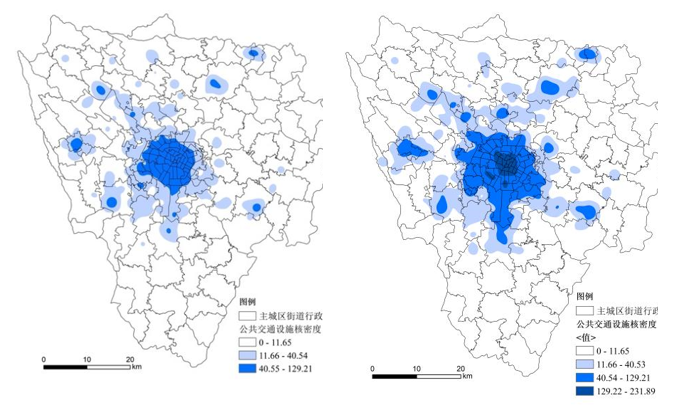 PDF(3161 KB)
PDF(3161 KB)


The Application of Digital Twin Technology in Megacity Transportation Planning: Taking Chengdu As an Example
Leye Yao, Yuxin Zhang
Knowledge Management Forum ›› 2023, Vol. 8 ›› Issue (4) : 329-339.
 PDF(3161 KB)
PDF(3161 KB)
 PDF(3161 KB)
PDF(3161 KB)
The Application of Digital Twin Technology in Megacity Transportation Planning: Taking Chengdu As an Example
[Purpose/significance] In order to effectively solve the traffic congestion problem in megacities, it is important to explore the effective application of digital twin technology in urban transportation planning. [Method/process] This article begins by providing an overview of the main content of digital twin technology. Secondly, it analyzes the spatial distribution of urban transportation facilities using the POI data from Amap, with Chengdu City as an example. Methods such as kernel density estimation are employed to examine the spatial distribution of urban transportation facilities in 2016 and 2022, aiming to grasp the current status and existing problems in the planning layout of transportation facilities in megacities. Finally, it explores the path for megacities to achieve digital twin smart transportation planning. [Result/conclusion] Chengdu has focused on alleviating the traffic congestion problem in the central urban area over the past four years. However, due to high land utilization in the central urban area, the existing roads have long been unable to meet the increasing daily traffic demands. Parking difficulties and the long time spent finding parking spaces have become the second challenge for citizens driving in the city. Although Chengdu has shown a trend of traffic overflowing from the central urban area, the pendulum traffic in the twin cities will still increase the pressure on public transportation during peak hours. Therefore, it is necessary to realize the digital twin intelligent transportation planning of megacities by laying out sensing equipment, using digital twin visualization technology, and improving P+R planning.

digital twin technology / megacity / transportation planning
| [1] |
周军,苏云亭,梁彦彦.治理城市交通拥堵的国际经验与启示 [J].价格理论与实践,2012(11):78-79.(ZHOU J, SU Y T, LIANG Y Y. International experience and inspiration in managing urban traffic congestion [J]. Price: theory & practice, 2012(11):78-79.)
|
| [2] |
王冰,张晓莲.公共政策的公共性测度——基于武汉市交通拥堵治理政策的实证研究[J]. 城市问题,2013(6):67-74. (WANG B, ZHANG X L. Public policy measurement: an empirical study based on Wuhan traffic congestion control policy [J]. Urban problem, 2013(6):67-74.)
|
| [3] |
马海涛,王凯,徐晓芳.新型城镇化进程中交通拥堵治理的税收政策研究 [J].税务研究,2014(11):21-24.(MA H T, WANG K, XU X F. Research on tax policy of traffic congestion control in the process of new urbanization[J]. Tax research, 2014(11):21-24.)
|
| [4] |
张力.伦敦现代城市交通体系建设与交通治理的经验与启示 [J].生态经济,2014,30(9):125-128.(ZHANG L. The modern traffic system construction of London and its experiences on how to solve traffic problems[J]. Ecological economy, 2014,30(9):125-128.)
|
| [5] |
卢文刚.基于复合治理视角的广东城市轨道交通应急管理框架对策[J]. 科技管理研究,2014,34(1):224-229.(LU W G. Compound governance study on capability assesment for rail transit emergency system in Guangdong[J]. Science and technology management research,2014,34(1):224-229.)
|
| [6] |
雷明全.治理交通拥堵中的政府失灵[J].现代经济探讨,2012(3):36-39.(LEI M Q. Government failure to deal with traffic congestion[J]. Modern economic research,2012(3):36-39.)
|
| [7] |
Omer M, Margetts L, Parwaiz M, et al. Use of gaming technology to bring bridge inspection to the office[J].Structure and infrastructure engineering,2019,15(10):1292-1307.
|
| [8] |
Beil C, Ruhdorfer R, Kolbe T H, et al. Detailed streetspace modelling for multiple applications: discussions on the proposed CityGML 3.0 transportation model[J/OL]. ISPRS international journal of Geo-Information,2020,9(10)[2022-10-24].https://www.webofscience.com/wos/alldb/full-record/WOS:000586892100001.
|
| [9] |
Lenfers U A, Ahmady-Moghaddam N, Clemen T, et al. Incorporating multi-modal travel planning into an agent-based model: a case study at the train station kelling husens trasse in Hamburg[J/OL].Land ,2021,10(11) [2022-10-24].https://www.webofscience.com/wos/alldb/full-record/WOS:000723729700001.
|
| [10] |
Saroj A J, Roy S, Hunter M, et al. Development of a connected corridor real-time data-driven traffic digital twin simulation model[J/OL].Journal of transportation engineering part A-Systems,2021,147(12) [2022-10-24].https://www.webofscience.com/wos/alldb/fullrecord/WOS:000708122300014.
|
| [11] |
林述涛.面向多源数据融合的交通基础设施数字化架构研究[J].公路交通科技,2018,35(9):122-127,145.(LIN S T. Study on digital architecture of transportation infrastructure for multi-source data fusion[J]. Journal of highway and transportation research and development ,2018,35(9):122-127,145.)
|
| [12] |
陈涛,易德新,高京生,等.基于建筑信息模型的宁波市城市轨道交通数字化建设管理研究[J].城市轨道交通研究,2019,22(12):48-52,56. (CHEN T, YI D X, GAO J S, et al. Study on digital construction management of urban rail transit based on BlM in Ningbo City [J]. Urban rail transit research,2019,22(12):48-52,56.)
|
| [13] |
张贵忠,赵维刚,张浩.沪通长江大桥数字化运维系统的设计研发[J].铁道学报,2019, 41(5):16-26.(ZHANG G Z, ZHAO W D, ZHANG H. Design and development of digital operation and maintenance system for Hutong Yangtze River Bridge[J]. Journal of the China Railway Society,2019, 41(5):16-26.)
|
| [14] |
罗燊,张永伟.“新基建”背景下城市智能基础设施的建设思路[J].城市发展研究,2020, 27(11):51-56.(LUO Y, ZHANG Y W. Thinking of urban intelligent infrastructure in the context of new infrastructure construction [J]. Urban development research,2020, 27(11):51-56.)
|
| [15] |
江涛,刘咏平.智慧交通中车路协同感知一体化平台设计[J].中国新技术新产品,2021(23):25-29.(JIANG T, LIU Y P. Research hotspots and progress on healthy city planning in China: a bibliometric analysis based on citespace [J]. China new technology and new products,2021(23):25-29.)
|
| [16] |
Glaessgen E H. Stargel D S. The digital twin paradigm for future NASA and U.S. Air Force Vehicles[C]//Proceedings of 53rd structure, structural dynamics, and materials conference: special session on the digital twin.Arlington: Air Force Office of Scientific Research, 2012.
|
| [17] |
Boschert S, Rosen R. Digital twin—the simulation aspect mechatronic futures[M].Berlin: Springer, 2016:59-74.
|
| [18] |
Grieves M, Vickers J. Digital twin: mitigating unpredictable, undesirable emergent behavior in complex systems [M].Transdisciplinary perspectives on complex systems,2017:85-113.
|
| [19] |
中国主要城市通勤报告[R].北京:中国城市规划设计研究院,2022.(Report on commuting in major cities in China [R]. Beijing: China Academy of Urban Planning and Design, 2022.)
|
| [20] |
向玉琼,谢新水.数字孪生城市治理:变革、困境与对策[J].电子政务,2021(10):69-79.(XIANG Y Q, XIE X S. Digital twin city governance: changes, dilemmas and countermeasures [J]. E-government,2021(10):69-79.)
|
| [21] |
ARGOTA SANCHEZ-VAQUERIZO J. Getting real: the chanllenge of building and validating a large-scale digital twin of Barcelona’s traffic empirical data[J]. ISPRS international journal of Geo-Information, 2022, 11(1): 1-28.
|
| [22] |
陈东静.城市交通规划中的问题及改善研究[J].建筑发展,2019,3(7):158-159.(CHEN D J. Research on problems and improvement in urban transportation planning, [J]. Architectural development,2019,3(7):158-159.)
|
| [23] |
周瑜, 刘春成. 雄安新区建设数字孪生城市的逻辑与创新[J]. 城市发展研究, 2018, 25(10): 66 -73. (ZHOU Y, LIU C C. Logic and innovation of building digital twin cities in Xiongan New Area [J]. Urban development research, 2018, 25(10): 66-73.)
|
姚乐野:论文框架设计,论文修改;
张钰鑫:初稿撰写,论文修改。
/
| 〈 |
|
〉 |